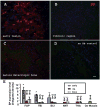Substance P signaling mediates BMP-dependent heterotopic ossification
- PMID: 21748788
- PMCID: PMC3508732
- DOI: 10.1002/jcb.23259
Substance P signaling mediates BMP-dependent heterotopic ossification
Abstract
Heterotopic ossification (HO) is a disabling condition associated with neurologic injury, inflammation, and overactive bone morphogenetic protein (BMP) signaling. The inductive factors involved in lesion formation are unknown. We found that the expression of the neuro-inflammatory factor Substance P (SP) is dramatically increased in early lesional tissue in patients who have either fibrodysplasia ossificans progressiva (FOP) or acquired HO, and in three independent mouse models of HO. In Nse-BMP4, a mouse model of HO, robust HO forms in response to tissue injury; however, null mutations of the preprotachykinin (PPT) gene encoding SP prevent HO. Importantly, ablation of SP(+) sensory neurons, treatment with an antagonist of SP receptor NK1r, deletion of NK1r gene, or genetic down-regulation of NK1r-expressing mast cells also profoundly inhibit injury-induced HO. These observations establish a potent neuro-inflammatory induction and amplification circuit for BMP-dependent HO lesion formation, and identify novel molecular targets for prevention of HO.
Copyright © 2011 Wiley-Liss, Inc.
Figures






References
-
- Forsberg JA, Potter BK. Heterotopic ossification in wartime wounds. J Surg Orthop Adv. 2010;19:54–61. - PubMed
-
- Cullen N, Perera J. Heterotopic ossification: pharmacologic options. J Head Trauma Rehabil. 2009;24:69–71. - PubMed
-
- Shore EM, Xu M, Feldman GJ, Fenstermacher DA, Cho TJ, Choi IH, Connor JM, Delai P, Glaser DL, LeMerrer M, Morhart R, Rogers JG, Smith R, Triffitt JT, Urtizberea JA, Zasloff M, Brown MA, Kaplan FS. A recurrent mutation in the BMP type I receptor ACVR1 causes inherited and sporadic fibrodysplasia ossificans progressiva. Nat Genet. 2006;38:525–527. - PubMed
-
- Kaplan FS, Glaser DL, Shore EM, Pignolo RJ, Xu M, Zhang Y, Senitzer D, Forman SJ, Emerson SG. Hematopoietic stem-cell contribution to ectopic skeletogenesis. J Bone Joint Surg Am. 2007;89:347–357. - PubMed
Publication types
MeSH terms
Substances
Grants and funding
LinkOut - more resources
Full Text Sources
Other Literature Sources

